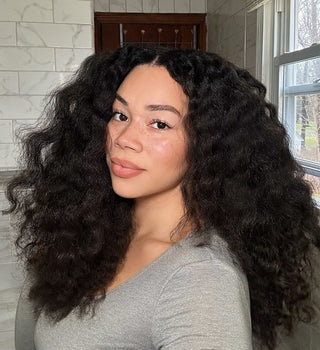Properly detangled hair is an important part of a healthy haircare routine, especially if you're trying to keep knots and single-strand knots at bay. However, If we're being honest, we all know the detangling process can be a little tedious and time consuming if you don't do it properly. This is why it is very important to learn how to detangle your curls to make your wash days and styling process go smoothly.
In this article, we're spilling the full step-by-step guide to finessing your natural hair detangling skills.
Understanding The Benefits Of Detangling Natural Hair
The shape of the follicles of natural hair makes it grow out in a spiral or ring-shaped pattern. This means your hair naturally loves to curl and fold back into itself, as a result, curly natural hair is very prone to tangles and knots. These tangles and knots can easily result in breakage when you try to style or manipulate the hair.
This is why it is very important to always make sure your natural hair is properly detangled. It will make it easier to style and also ensure your moisturisers and styling products are evenly distributed across the strands. Detangling the hair also helps prevent frizz and makes it easier to retain length as you will be reducing the number of potential breaking points along the hair where there could be any breaking or snapping.

When Should You Detangle Natural Hair?
You do not have to detangle your hair every day. For one that would be too time-consuming and secondly, it is really not necessary as that would be too much manipulation. However, you will need to thoroughly detangle on every wash day. For smooth, tangle-free curls, aim to detangle twice on washday. Once before your shampoo and after applying your conditioner. You can use our Moisture Rich Conditioner to help soften your hair and lubricate your strands while you do this.
Additionally, you may want to detangle the hair before styling it as certain hairstyles require the hair to be very smooth. You can use our Manuka Honey Leave-in Conditioner to add slip to your hair while you do this.
Another moment when your hair may be in need of some serious detangling is when you are taking down a long-term protective style like box braids or twists. Your hair requires a gentle and thorough detangling session after these hairstyles, and it is best to do it immediately before the hair gets wet. Soaking the hair in water without detangling it can make the hair matted and make the detangling process much harder. While taking down your braids, you'll need to spray each section with our Everyday Curl Refresher to help soften the hair and make it easier to loosen any knots and tangles.
Damp vs Wet Detangling
As we've mentioned before, natural hair is best detangled with something to help lubricate the strands. However, the question becomes, should you completely wet the hair or just leave it damp? Well, it all depends on the situation. In both cases, the hair becomes much softer and less clumped together, making it easier for your comb to glide through seamlessly. However, the hair is best detangled wet when you do not have too many tangles and knots as too much water can make it slightly harder to get in between those knots. This means wet detangling is best suited to wash days when you are in the shower and the hair has not been left tangled for a long time.
On the other hand, damp detangling works best on matted. It is also perfect for when you are trying to style hair that has already been washed as there is no need to soak up the hair with excess moisture.

Should You Comb Or Finger Detangle?
Those with extremely tight curls probably already know that sometimes even a comb is not enough to make the detangling process pain-free. This is why the natural hair community introduced the concept of finger detangling. This essentially means using your fingers like a comb to glide through your hair, gently releasing any knots and tangles as you go.
Now in terms of what technique is better, it all depends on you. Both combing and finger detangling have their perks and pitfalls. With finger detangling, you can easily get through to every nook and cranny of your hair, without causing any pain, damage or yanking out too much hair. However, it is a very time-consuming process. Finger detangling on type certain hair types can sometimes take as long as one hour. With a comb, you will be able to finish much quicker, but your tight coils may not get the thorough attention they need.
It all depends on your personal preference, try out both techniques and see which one you prefer. If you want to be as detailed as possible, you can finger detangle first and then follow up with a comb.
How To Detangle Natural Hair Without Breakage
To detangle natural hair without any hassle. Stick with the following steps.
- Divide the hair into 4-6 sections. Try to make sure the centre of your hair is a separate section on its own as that area sometimes requires a little extra attention. Use a hair clip to secure each section.
- Next, spray the hair with a little bit of warm water If you are damp detangling. If this is your wash day and your hair is already wet. Simply move on to the next step.
- Working one section at a time, apply our Moisture Rich Conditioner to help lubricate the hair strands if you have just washed with our Hydration Shampoo. If not, simply work in a dollop of Sofnfree's Manuka Honey Leave-In Conditioner. Make sure the product properly coats the hair from roots to ends.
- Then grab your comb or use your fingers to comb through each section from roots to ends. If you are using your fingers, try to feel for any tangles and knots and spend a little time releasing those knots. If you are using detangling tools, start with a wide tooth comb and then follow up with a brush or tangle teezer.
- If you need a little extra slip as you detangle, you can apply a small amount of our Hair & Scalp Oil as you go.
- After detangling each section, proceed to either wash off the product or style the hair as desired.
Pro-tip: Try to be as gentle as possible and take your time. Rushing through the process will only result in a ton of breakage and an undesired outcome.
Additionally, try not to detangle your curls and coils when you are angry or frustrated. This may seem like an unnecessary tip but trust us we're speaking from experience. You will not be as gentle as you need to be when you are angry, and you may end up yanking at your hair and transferring aggression to your previous strands.
Things To Avoid When Detangling Natural Hair:
- Avoid Using The Wrong Tools: Using the right combs and brushes for your hair is very important if you want a painless detangling session. So, avoid using combs and brushes with fine tooth or bristles as they will have a harder time going through your strands and can cause breakage. Try to use a wide tooth comb or a paddle brush when you are detangling.
- Do Not Detangle Dry Hair: Always, always, avoid detangling your hair when it is dry. It will be very painful and also break off your curls, leaving you with a lot of hair loss. Instead, make sure your hair is either wet or damp.
- Don't Detangle From The Roots: Detangling your hair from the root is another thing you should avoid at all costs. When you put your comb in from the roots, all the knots and tangles that are along the rest of the hair will get in the way, making the whole process incredibly painful and increasing breakage. This is why it is best to start at the ends of your hair and then work your way up, gradually releasing any knots and tangles until you get to the root.
- Don't Detangle In Large Sections: Going at your full head of curly or coily hair with a comb is a recipe for disaster. You will not be able to properly detangle each section and it will result in more breakage than you'd like. So, it is best to work in small sections. Depending on how thick your hair is, you can divide the hair into 4-6 sections.
Detangling your natural hair can seem like a difficult task at first but once you follow all the steps in this guide, you'll become a detangling pro, and your curls and coils will thank you for it. Don't forget to be gentle and handle each strand with as much care as possible. This is your time to give your hair a little extra attention so don’t be in a rush.

